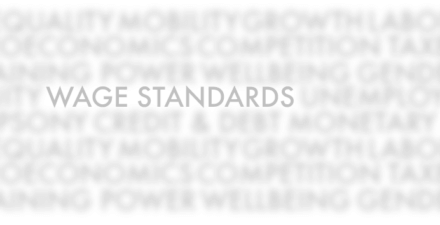Overview
Equitable Growth in Conversation is a recurring series where we talk with economists and other academics to help us better understand whether and how economic inequality affects economic growth and stability. In this installment, Equitable Growth Director of Labor Market Policy Kate Bahn talks with Jake Rosenfeld, a professor of sociology at Washington University in St. Louis, where he studies the causes of economic inequality in the United States and other postindustrial economies, particularly the determinants of wages and salaries and how these vary across time and place. His most recent book, You’re Paid What You’re Worth and Other Myths of the Modern Economy (Harvard University Press, 2021), challenges the idea that workers are paid according to individual performance or inherent features of their jobs, and places power and social conflict at the heart of economic analysis.
In a recent conversation between Bahn and Rosenfeld, they discuss:
- The dynamics within and between U.S. workplaces that determine pay-setting processes
- How new research surveys show us that much of what we think determines our pay is wrong
- The role of power in the pay-setting process
- Policy ideas to improve employers’ pay-setting practices for U.S. workers
- The importance of interdisciplinary research by economists and sociologists on the pay-setting process
Kate Bahn: Thanks for taking the time to talk today, Jake. You have a new book out, titled You’re Paid What You’re Worth and Other Myths of the Modern Economy. I think it’s an important framework for understanding what determines pay, how it’s changed over time, what this means for rising economic inequality, and what to do about it. So, I’m really looking forward to talking about that and your other research on labor a little more.
Jake Rosenfeld: Well, great, thanks so much, Kate, and it’s a real pleasure to be here.
The dynamics within and between U.S. workplaces and the U.S. labor market that determine pay-setting processes
Bahn: So, to start, you outline a new framework for understanding what factors determine pay. What are the specific dynamics that you define? What is the schema you set up for pay determinants? What makes this so different, compared to the dominant human capital theory in economics? And then also, what makes this an expansion of what the work has been in sociology?
Rosenfeld: That’s a great set of questions. The impetus behind the book was the growing frustration about the longstanding idea that your pay is an individual-level phenomenon. This idea is rooted in academia, as well as within the general public and among policymakers. Basically, the idea is that what you get paid is based on your own relevant acquired skills and natural aptitudes, and that’s rooted in the so-called human capital model of pay.
More recently though, there’s been this flourishing of work at the intersection of various disciplines, including labor economics and sociology and organizational studies, featuring scholars who are taking organizations and organizational-level dynamics more seriously. So, in this book, I’m drawing on all this new, exciting research to reframe our common understandings of pay determination.
I do want to be clear, however, that the human capital you bring to a job—and your subsequent performance at your workplace—does matter. For one thing, your skills and relevant expertise get you in the door in the first place. I can’t just pass myself off as a neurosurgeon tomorrow and expect to be paid anything. But once hired, I argue that your human capital is just one factor among many others influencing your share of the pie.
These other factors loom large. I really take seriously, first and foremost, your power—meaning your ability to get your way, even in the face of opposition—and also the factors of inertia, mimicry, and equity. And I’m happy to talk in brief about what those are and how they do influence pay if you’d like.
Bahn: Please do.
Rosenfeld: Sure. So, inertia is an idea that grows out of a longstanding organizational scholarship in a variety of disciplines. The idea here is that for many of us, the overt battles over pay occurred prior to when we showed up at the firm. Upon being hired, we are either told “here’s what you’re going to make” or are given some very small room to negotiate. Inertia is a property of workplaces where claims made and validated in the past over shares of the available pie, well before you ever started the job, determine what your job pays today. Inertia is an idea that pay attached to particular jobs assumes a “taken for grantedness.”
Mimicry often comes from the inertia at one organization leading to copying by others. So, mimicry describes a common process through which your employer pays the going rate for your position in your industry. This is what’s going on when your employer says they pay the market rate. They may indeed do that, but I think that invoking the “market” obscures more than illuminates and conjures up images of these implacable forces out there, beyond human control, over which you have no control. And I think that’s fundamentally misleading.
And then, employers also mimic or copy one another to maintain a notion of equity among workers. Equity is the notion of paying fairly, and it can affect your pay in a number of ways. So, part of my book explores what happens when workers are allowed to find out what their co-workers are making. And from a researcher’s point of view, that’s a fascinating experiment because once that information is out there, you see all sorts of norms of equity come to the fore, often in quite messy ways.
Bahn: I find it very interesting that these concepts of power, inertia, and mimicry support an ostensibly equitable market rate of pay. Can you describe how these social factors reinforce what is ultimately a clear economic rationale for employers to insist that market forces naturally support current structures of pay?
Rosenfeld: Sure. I think that’s quite fundamental. First of all, in the book, I’m clear that broader demand for your organization’s product or services matters. It’s a constraining factor on your pay. You could be the most talented, persuasive, and powerful person at your firm, but if there’s no revenue to be shared, you’re not going to get much. Demand for labor also matters because the particular type of jobs that you can perform obviously matter. Those are two constraining factors that set the broad parameters for what you end up getting paid.
But that’s it. They are parameter-setters.
Then, looking across organizations and within organizations over time, there are all sorts of variation in terms of what people earn. And so, I think, too often, employers and others say “well, the market has dictated this wage. We can’t offer you any more because that’s just what the market is determining right now.” That’s used as an excuse, and in fact, there’s a lot more room to maneuver. The forces of mimicry, inertia, power, and equity often do really determine that variation of where you land on the particular pay scale at a particular point in time.
How new research surveys show us that much of what we think determines our pay is wrong
Bahn: You also conducted your own surveys for this book. What were the questions you were interested in asking? Who were you talking to? And then, sort of overall, what did this reveal about the larger dynamics behind pay setting that are often underappreciated determinants of pay, and in economics research in particular?
Rosenfeld: In writing this book about why we get paid what we do, I set off on the research as a starting point by casting about looking for information about what workers think determines their pay, compared to what factors actually underlay their pay. And it turns out there’s kind of next to nothing out there, which was disappointing and set me back timewise. So, I first commissioned a survey of about 1,100 workers and then another survey of about 160 employers because I wondered what employers involved in the pay-setting process would say about what factors they think determines wage assignment and how they determine wages and salaries.
In the surveys, I asked key questions based on a list of factors drawing from academic research and common understandings of pay determination, things such as seniority, education level, occupation, company performance, as well as those types of factors associated with individual performance. And in both surveys, I asked workers and pay-setters, “what do you think are the most important factors in terms of determining the number on your paycheck?” And then, “what factors do you think should be key in determining the number on your paycheck?”
Both sets of surveys revealed similar findings. And I will say they were surprising. No factor ranked as highly as individual performance. This is the number 1 factor workers say determines their pay and the number 1 factor pay-setters say they use in setting pay. Basically, my whole book is about how they’re wrong, so these topline survey findings are a little uncomfortable, but I think, upon reflection, this commonplace idea that your pay is rooted in your individual performance reflects a longstanding individualistic tendency within our culture and also reflects the primacy of the human capital model of pay.
This is the case even if, for a long time now, many labor economists have augmented that model, complicated it, and, in some cases, set it aside. Yet its power still looms large.
Bahn: So, it seems these cultural factors inform our theoretical understanding of the world, and we can’t detach those two things from each other. And these cultural forces are informed by the power structures we have in society already. Taking these cultural forces into account, how convenient is it that economists and other social scientists developed a human capital theory of pay that basically says rich people deserve to be rich because, of course, that’s what they would want people to say?
Rosenfeld: Absolutely convenient. That’s putting it quite succinctly. Rooting pay within individual performance can be used to excuse any existing pay inequalities you see out there in the world. And so, we see that today, within and beyond academia, people who say astronomical CEO pay must reflect their astronomically impressive performance, one that’s grown dramatically over the past couple of decades, according to that theory.
Bahn: And it’s same situation on the other end of the earnings spectrum, that people who don’t earn a lot must just not be valuable.
Rosenfeld: Of course. And it’s defined as a skills-deficit issue. If you’re not being paid a lot, then you need to go out and augment your skills to turn things around.
The role of power in the pay-setting process
Bahn: Switching gears a bit, you note that you place a big emphasis on the role of power, which, in turn, reflects a variety of institutional factors. So, to get into a specific example, I want to go back to your previous work, in the book What Unions No Longer Do, where you talk about some of the implications of declining unionization in the United States. In that book, you do some data analysis on strikes as a tool for collective action. You find that not only did strikes decline starting in the mid-1970s, but also that where workers were striking and the outcomes of those strikes shifted within this longer term decline. Can you describe what you found out about the role of strikes and how that shifted over time?
Rosenfeld: Sure. Worker power, especially among workers without a college degree, has declined precipitously in this country, and that’s due, in large part, to the decline of the primary set of organizations that augment worker power: labor unions. It’s commonly known now that union representation rates have fallen off a cliff in the private sector from their peak in the mid-1950s. What might be less commonly understood is the decline in strikes has been even more precipitous.
As union representation rates began to decline, strike rates really just bottomed out. This is in the context of a country that, at one point, led the world in the rate of strikes. And now, with the exception of the past couple of years where we’ve seen some interesting resurgence of worker activism within teaching and a few other industries, such as hotel workers in Chicago, hardly anyone strikes.
The research that I had done previously established that the few strikes that do occur rarely translated into demonstrable improvement for the workers involved. And that’s in contrast to past scholarship, which found, unsurprisingly, that strikes have an economic benefit and are a key reason why unions would call their workers out to strike. Strikes are inconvenient and awful in many cases for everyone involved. This is not something that unions plunge into willy-nilly, but they were the most powerful weapon in labor’s toolkit and once you take that out, unions are quite limited in their ability to get their way in negotiating with management. And that’s certainly what we have found looking at the data.
Bahn: As an extension of that, unions as the source of worker power and pay setting also interact with other forces of systemic inequality. So, for example, in your paper with University of Maryland, College Park sociologist Meredith Kleykamp on organized labor and racial wage inequality, you found that unions offset discriminatory treatment facing Black workers. Can you tell us more specifically about what you found in that work, and what does this say about how these broad social structures are relevant to pay setting beyond what you find within organizations?
Rosenfeld: Sure. I don’t know how much of an origin story you want here, but many years ago now, Meredith Klaykamp and I were working on a separate paper on Hispanic immigrant union organizing and throughout the analyses for that paper, what kept popping out from the data, time and time again, was the disproportionately high unionization rates of African Americans—and that includes African American women, as well as men—during the 1970s, which is when our analysis began.
Meredith and I subsequently wrote up these findings in the paper you refer to. Our findings challenged a longstanding notion within labor scholarship and the broader public that unions had this racist exclusionary cast about them. That history is true, I want to be very clear, with limited exceptions. But by the 1970s, it’s also equally clear that no population was more overrepresented in unions than African Americans. And we make the argument that unions provided a set of protections for pay and working conditions that African Americans were unlikely to find elsewhere, especially in nonunion private-sector workplaces. And that was surprising.
And the problem was that African American union representation rates in this key institution augmenting worker power really peaked just as organized labor was really starting to decline. And so they were never able to enjoy union membership in durable organizations that provided for worker protections over a long period of time. But what’s also clear in our research is that unions, and the overrepresentation of African Americans in them, were key to narrowing racial wage gaps, especially among women workers, right up until those representation rates started to plummet.
This highlights the importance of a broader understanding of organizational dynamics, whether we’re talking about the presence or absence of labor unions and whether we’re talking about the presence or absence of key workplace information. So, in my most recent book, and in some other recent research, I’ve looked at how the ability to discuss wages and salaries may help women workers in particular because you don’t know whether you’re being discriminated against if you can’t find out what your co-workers make. And we do know that among organizations, employers vary dramatically in the stance they take toward either facilitating the spread of that information or making sure it’s kept tightly under wraps.
Bahn: There seem to be these two trends working in opposite directions, workplace inclusion and access to workplace information. Likewise, about when minimum wage was expanded to cover more sectors that included more African American workers, the real value of the minimum wage started to decline. It’s sort of a similar trend with unions. Unions became more inclusive, but then union organization levels declined. Perhaps similarly, as more women entered the workforce beginning in the 1970s, the tools that existed within organizations to help with pay transparency or other factors probably also declined. So, it’s like these two trends happened in opposite directions at the same time. Just as workplaces might become more inclusive, legally speaking, there also were tools that were used to limit how fair they are.
Rosenfeld: Yeah, I think that’s fair. The progress here isn’t linear and what we’ve learned, and the Washington Center for Equitable Growth has done some great work on this, is that simply putting a new law on the books is no guarantee that it’s going to translate similarly across organizations, or that employers are going to obey it in the first place. Noncompliance when it comes to the nation’s worker protections, I think, is a key issue, and one that does not get the attention it deserves and one that I certainly discuss at length in my most recent book.
Policy ideas to improve employers’ pay-setting practices for U.S. workers
Bahn: What does the framework in your research tell us about the policies that would be needed to reduce economic inequality? Are policies that are aimed at improving wages different depending on the context? How does a worker’s position in the income distribution or the type of job they’re in influence how policies affect them?
Rosenfeld: Those are great questions. I have a set of policies and policy recommendations that aim to raise the wage floor, expand the middle range of incomes, and lower pay for those at the top. And the broader backdrop here is that for too long, policymakers’ toolkit for addressing inequality, to the extent they took it seriously, had to do with increasing workers’ skills. The human capital theory of pay basically said, “let’s get more people in college and let’s get more Americans enrolled in college,” and inequality would magically solve itself. I work at a college, and I am all for increasing enrollment for any number of reasons, but simply doing so, especially at the margins, is not going to solve this incredibly pressing issue.
I think there’s a set of broad-based, universal policies that include expanding the minimum wage, which is in the news right now, along with policy levers that would aim to change employer behavior, given what we know from some exciting new research, that’s just emerging about how important where you work is for what you’ll get paid. You can get hired at Sam’s Club and Costco today with the same resume, for example, but your subsequent pay and working conditions couldn’t be more different. And so, it’s about how do policymakers help create more Costcos and fewer Sam’s Clubs going forward?
The distribution of pay matters, especially for middle-wage and low-wage jobs. And this is where policmakers want to look at things such as contracting with the federal government and doing things like prioritizing firms that have moderate CEO-to-average-worker pay ratios and high median wages for nonsupervisory employees, when it comes to federal contracting standards. And what policymakers should try to do is get this established, and established quite quickly, as a common practice and then other employers who don’t contract with the federal government will start to mimic those that do. All of a sudden, high-road strategies take root and inertia process takes hold and the high road becomes the norm, whereas for too long, it has proven the exception.
The importance of interdisciplinary research by economists and sociologists on the pay-setting process
Bahn: So, those were the questions I have, and I want to thank you for your time. Thank you so much. I really liked what I’ve read of the book so far, and I’m delighted to be able to give you a platform to talk about it.
Rosenfeld: Oh, sure. It’s a thrill. I’m excited.
Bahn: I also really appreciate, as a labor economist, reading something that is just a thorough literature review of what sociology has to inform us about the pay-setting process.
Rosenfeld: I will say that over the past 5 years, the sea change within labor economics has been encouraging, incredibly encouraging, and not something I would have anticipated. So, we’re all coming together.
Bahn: That’s true. And there’s more indiscriplinary work to do, too, which is promising.
Rosenfeld: The work you guys are doing, along with some of the other think tanks, is inspirational as well.
Bahn: That’s great to hear. Thank you.
Related
Rebuilding U.S. labor market wage standards
In conversation with Alexander Hertel-Fernandez
Explore the Equitable Growth network of experts around the country and get answers to today's most pressing questions!






